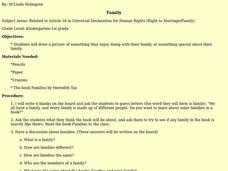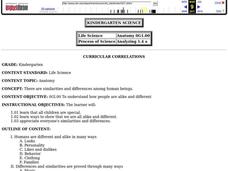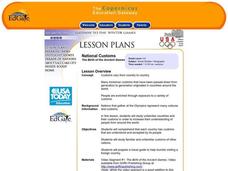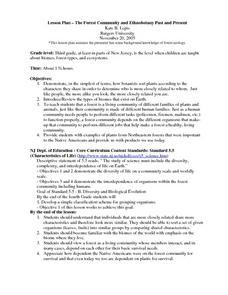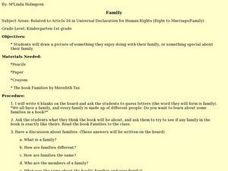Curated OER
Plants and Animals: Alike and Not Alike
After reading an informative paragraph that outlines some of the differences between plants and animals, fifth graders attempt to correctly categorize 12 words in a word bank. They must put them in the plant, or animal category. This...
Curated OER
We are all alike, We are all different
Students investigate similarites and differences. In this multi-cultural lesson, students discuss how people are alike and how they are different by comparing apples to people.
Curated OER
We Are All Different in Many Ways!
Pupils discuss differences such as skin color, eye color, hair color, emotions, families, etc., to reinforce that it is okay to be different.
Pennsylvania Department of Education
Alike and Different
Students compare and contrast objects and are introduced to a Venn Diagram. In this alike and different lesson plan, students make observations regarding properties of objects. Students classify object and build ideas about variables....
Curated OER
Fact Families to 18
In this fact families to eighteen worksheet, pupils problem solve six word problems associated with fact families to eighteen.
Possibilities
Disability Awareness Activity Packet
Bring awareness to disabilities with a packet consisting of a variety of activities designed to inform scholars about disabilities—autism, hearing impairments, physical disabilities, and more! Learners test their communication...
Curated OER
Two Snails
In this two snails instructional activity, students observe and spot the differences between a picture of two families of snails and circle each one they find.
Curated OER
French and Family
Where is France? Interest young learners in exploring France, French language, and French culture. They identify similarities and differences between French and American families, speak the French words for family members, analyze maps,...
National Endowment for the Humanities
La Familia
Young scholars identify at least one country where the Spanish language is spoken, describe similarities and differences between Spanish, Mexican, and Puerto Rican families, and practice speaking the Spanish words for several family...
Curated OER
Double Jeopardy-Homophones
Second graders identify homophones as words that sound alike but have different meanings. They, given a pair of homophones, are to explain the meanings of the words using gestures, role playing, or drawing a picture with their partner.
Curated OER
Who's In The Fact Family?
Young scholars study related addition and subtraction facts. In this math instructional activity, students use related addition and subtraction to solve problems. Young scholars use manipulatives to explore fact families.
Curated OER
I Am Special and You Are Special Too #6
We are All Alike…We Are All Different is the springboard for the creation of an illustrated book in which young writers record their impression of themselves, their families, and their interests. Sharing the completed books in circle...
Curated OER
Growing on My Own, Kids on the Grow
Students participate in an after school program that promotes critical thinking, concern for others, recognizing differences, accepting differences, self-motivation and personal safety. They cover how kids develop, expressing different...
Curated OER
Anty-Bodies
Students compare and contrast likenesses and differences to others by creating a life-size picture of themselves. In this character building lesson, students dictate a sentence about comments on sharing and display them with their...
Curated OER
Family
Students listen to a teacher read aloud of a book about families before discussing what a family is to them. They discuss how families can be the same or different, who they are made of, and what their traditions might be. They draw a...
Curated OER
Saving Makes Cents
Students identify ways families save money. In this financial lesson plan, students read the book A Chair for My Mother and discuss ways to save money. Students identify coin values and practice counting money.
Curated OER
Anatomy
Students explore the similarities and differences in human beings. They consider that all students are special, and appreciate everyone's similarities and differences.
Curated OER
Go Fish
First graders explore rhyming words. They listen to the book One Fish, Two Fish, Red Fish, Blue Fish and discuss the rhyming words. After being placed into groups, they play the game, "Go Fish" and find matching rhyming words. They...
Curated OER
Genetic Variation
Students study families and their genetics. In this investigative lesson students explain how variations in genetics can be harmful and how some can help with survival.
Curated OER
National Customs: The Birth of the Ancient Games
Students discover that different countries have different customs. Using the internet, they research the familiar and unfamiliar customs of a country they are interested in. They work together to create a travel brochure to help...
Curated OER
Christmas Celebrations
Second graders view a video of the Nutcracker ballet and then compare and contrast holiday celebrations in Germany and the United States. They use the computer to write a paragraph exploring their observations.
Curated OER
The Forest Community And Ethnobotany Past And Present
Students describe a forest as a living community. They determine members interact, and in many cases, depend on each other for their basic survival needs. They investigate how dependent the Native Americans were on the forest...
Curated OER
The Good Life
Young scholars explore the world of credit. In this finance lesson, students examine the use of credit and discuss financial fitness. Young scholars create a brochure or poster to educate others on the types of credit and how to stay...
Curated OER
Family
Students draw a picture of something they enjoy doing with their family, or something special about their family. Students share their pictures with the class, and then they will be displayed in the classroom.
















